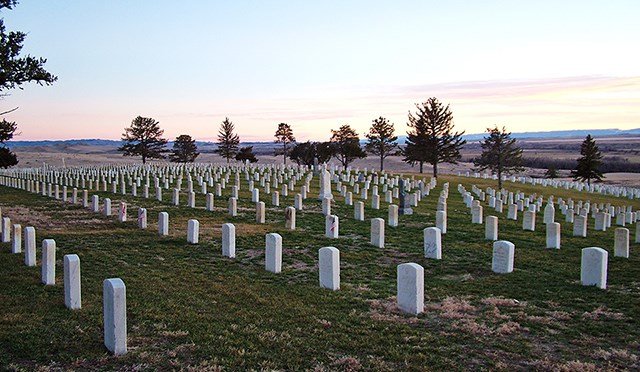Little Bighorn Battlefield National Monument
There is a good chance that this post contains affiliate links. If you click on any of these links, we might earn a small commission at no extra charge to you (which we very much appreciate, thank you!) The full disclosure policy can be found here.
On your next I-90 road trip through Montana spend a day in history at the Little Bighorn Battlefield National Monument. This National Park memorializes the US Army’s 7th Cavalry, Crow, and Arikara scouts and the Lakotas, Cheyennes, and Arapaho in one of the American Indians last armed efforts to preserve their way of life.

When you arrive visit the Visitor Center to watch the 20 minute video “Triumph & Tragedy Along The Little Bighorn” as an orientation to the Battlefield. The video helps give content for the rest of your visit. Also explore the Museum and Bookstore before exploring the grounds.

Next visit the Indian Memorial and the 7th Cavalry Monument on top of Last Stand Hill, a.k.a. “Custer’s Last Stand.” The bronze sculpture silhouetted against the sky is of three warriors riding to battle and a woman handing off a shield to one as she watches them ride off seemingly into the sky, where the spirit world dwells according to traditional tribal beliefs. The artist wanted to show a woman’s perspective of this battle and its turning point in American history. It’s a beautiful sculpture that embodies the message “Peace Through Unity”.

Now walk the Deep Ravine trail, a 1/4 mile self-guided walking tour. The route was laid out almost immediately after the Battle of the Little Bighorn in 1876. Army personnel erected temporary wooden stakes made from tipi poles to mark each grave site. Later in 1890, Army personnel erected white marble markers. Some Lakota and Cheyenne families and tribal members marked the casualty sites of their loved ones who died in the battle with small stone cairns. In 1999, after consultation with Cheyenne and Lakota tribes, the National Park Service began marking these sites with red granite markers to preserve them. Today you can see these markings scattered along the rugged natural landscape as you walk the Deep Ravine trail.


Time to explore the Custer National Cemetery. Look for the audio tour signs, it will give you a number to call from your cell phone and it will give you a guided tour of the cemetery. National Cemeteries were created after the Civil War where so many deaths took place, putting the responsibility on the government for identification and burial of the dead. In National Cemeteries all rests are equal. In the Custer National Cemetery, for example, Brevet Brigadier General Marcus Reno is buried directly beside Private Dale Hepler, conferring to each soldier an equal honor in death regardless of their military rank or socioeconomic status in life. If you are looking for a particular gravesite use the National Cemetary Adminstration’s Nationwide Gravsite Locator.
Finish off your trip to the Little Bighorn Battlefield National Monument with a 4.5 mile driving tour to the Reno-Benteen Battlefield, the second stage of the Battle of the Little Bighorn. Purchase the full guided audio tour CD or drive out on your own and use the cellphone markers along the way to get all the details at each stop along the tour road.

Spend a day exploring Little Bighorn Battlefield National Monument in beautiful Montana on your next midwest road trip. The history and beauty at this National Park makes this visit well worth it. Make sure to grab your National Park pass before hitting the road on your next adventure. Happy Travels 🙂















